ASUS Zenbook Prime (UX21A) Review: The First of the 2nd Gen Ultrabooks
by Anand Lal Shimpi on May 22, 2012 2:46 PM EST- Posted in
- Laptops
- CPUs
- Asus
- Ivy Bridge
- Zenbook
- Zenbook Prime
- Ultrabook
- Notebooks
GPU Performance
Peak synthetic GPU performance sees a sizeable boost compared to the previous generation Zenbook. 3DMark 11 requires DX11 hardware and thus the original Zenbook won't run on it, but the rest of the 3DMark tests give us some perspective.
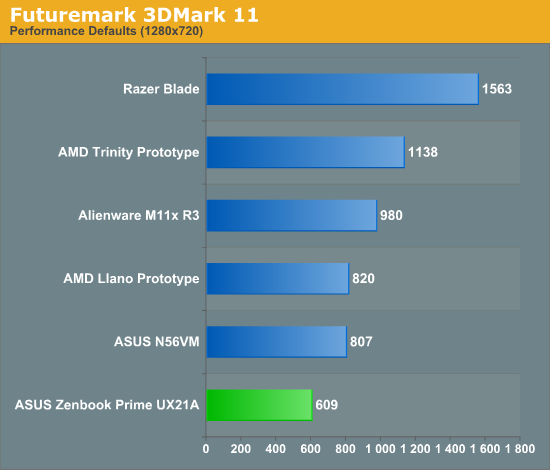
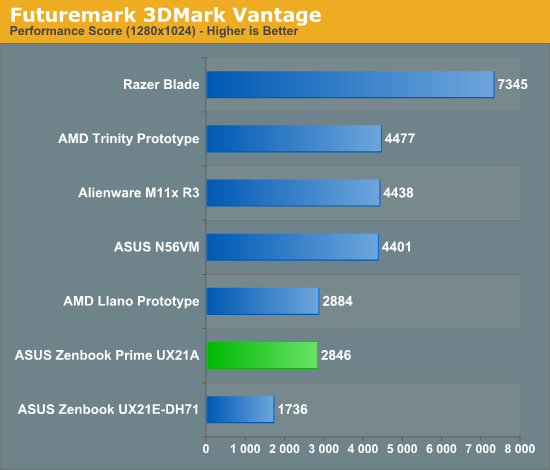
Vantage shows us a 63% improvement over the HD 3000 based Zenbook UX21.
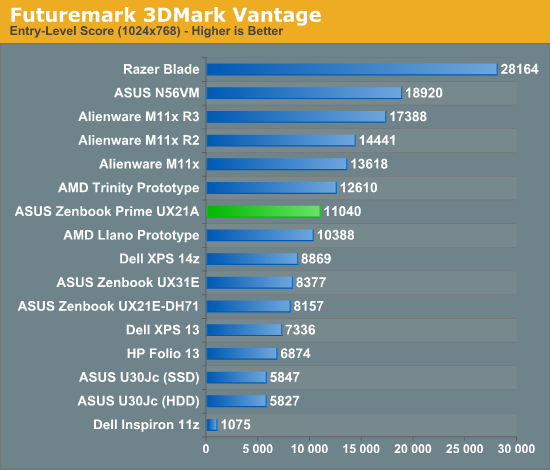
Here we see just how much better Intel's graphics cores have gotten over the years. The Inspiron 11z could barely run the entry level 3DMark Vantage suite, whereas the Zenbook Prime delivers nearly an order of magnitude higher score here.
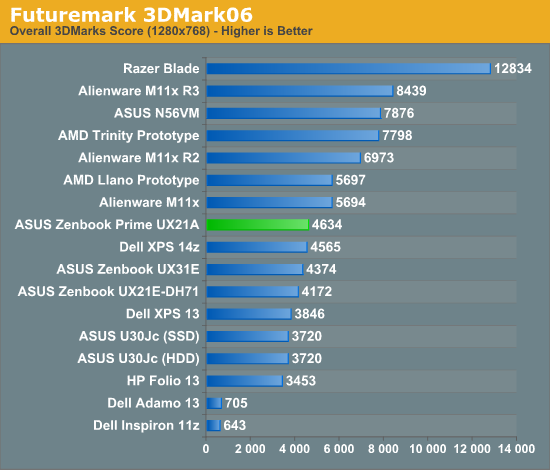
Gaming Performance
We can say that the silicon in the Zenbook Prime's CPU features Intel's HD 4000, the upgraded 16 EU Ivy Bridge GPU. The result should be much improved gaming performance. Once again we are thermally limited so there are some cases where you won't see tremendous increases in performance.
At a high level, for any modern game, you shouldn't count on being able to run it at the Prime's native 1080p resolution. You need a discrete GPU (or Haswell) to pull that off. The former is a tall order for a machine that's already mostly battery. The good news is that 1366 x 768 is playable in many games.
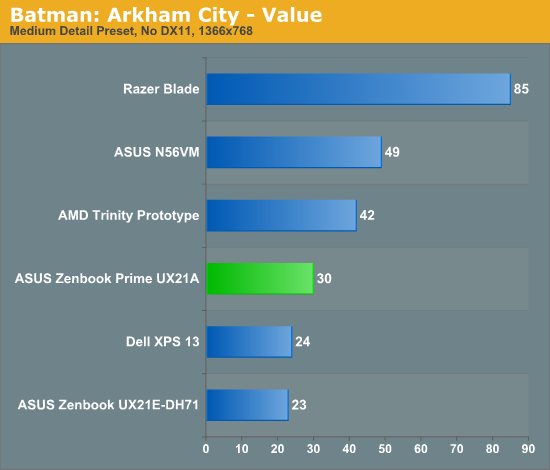
Not all games will see huge performance gains, but the latest Batman title runs 30% quicker on the new Prime.

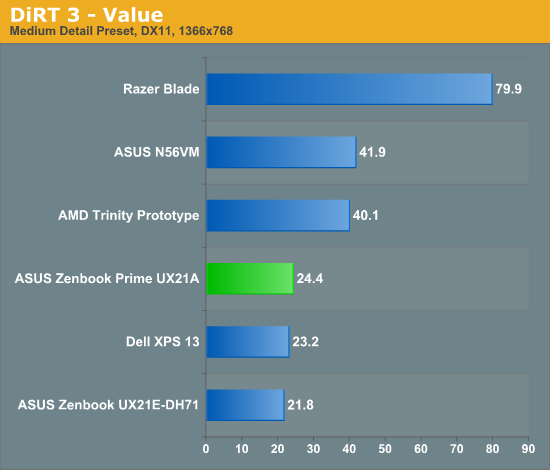
More CPU constrained and thermally bound environments won't show any improvement over the Sandy Bridge based Zenbook UX21.
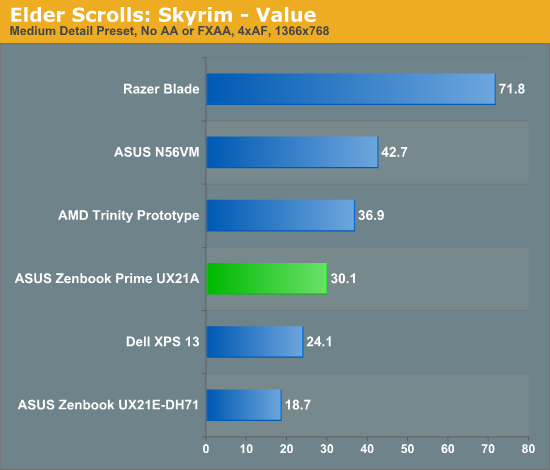
The 61% increase in performance over the original Zenbook takes the Prime into the realm of playability at these settings.

Portal 2 is an interesting case as we are significanty CPU and thermal bound here. The Prime can reach frame rates as high as 39 fps, but after a couple of runs you see degradation into the 32 - 37 fps range. On average, there's no improvement in performance compared to its predecessor - there's no beating the laws of physics.
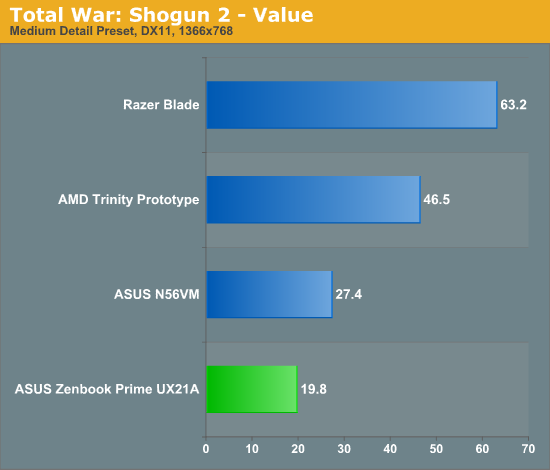
Diablo III
Last week Intel proudly showed me a demonstration of Diablo III running on Ivy Bridge's processor graphics, from a standard notebook all the way down to an Ultrabook. Eager to repeat the experiment myself, I fired up Diablo III on the Zenbook Prime.
Default settings at 1920 x 1080 were understandably unplayable. Dropping the resolution down to 1366 x 768 and clutter density down to medium however gave me an average of around 17 fps outdoors and 20 fps in early crypts. Given that Diablo isn't a twitch shooter, these frame rates were actually playable - all I needed was an external mouse.
As a primary gaming system, any Ultrabook this size is going to fall short. However, if you need to get your Diablo fix in while on the road, the Zenbook Prime will deliver in a pinch.



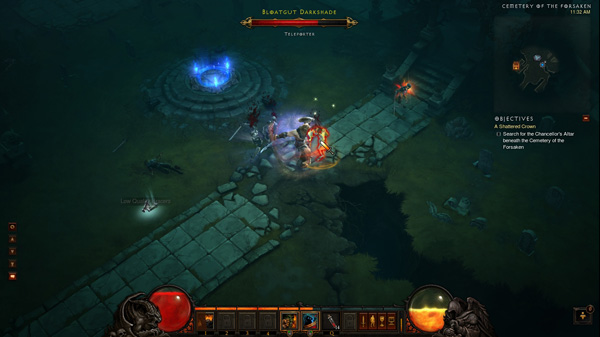








192 Comments
View All Comments
eanazag - Tuesday, May 22, 2012 - link
I will mimic some of the same things about the memory being a little low. Put 4GB onboard and leave a slot to get to 8GB. I'd actually prefer to role the dice with the Sandforce SSD. I would realistically go for the larger machine that can house the nVidia card and more mem. I appreciate gigabit ethernet too, but could make do given the point of the device. Now a little 802.11ac could cure my cabled ethernet needs.My gripe about the 32x is: where'd the screen go? Give me a video card and take away the display? I hope it is an option.
Comparisons:
When looking at the benchmarks, the numbers for Alienware M11 R3 are really good. It is a travesty they are pulling that product at this time. A hardware refresh would hum on it. I was really considering it.
Trinity - I have been thinking about the bulldozer and trinity products and I truly believe that it is AMD's version of hyper-threading. They are seemingly competitive when compared by module count. Their product makes sense in that light. On AMD, I'd really like to see a 150-200W trinity desktop product that can powergate the excess GPU when not needed. Make a product that no one else can make AMD. Give some of us a beast. I'm running a 100W processor and 200W video card now. I'd still get a power savings and heat reduction.
Sunburn74 - Tuesday, May 22, 2012 - link
4gb is fine. The equivalent 11inch macbook air has only 2gb of ram and is considered a marvelous machine. Most people are using only 4gb of ram in their desktops. 4gb is fine. Low profile, ULV machines are not what you want to be using for ram heavy work.Reflex - Wednesday, May 23, 2012 - link
While I can make due on 4GB, it really is non-optimal. I'm not doing anything that requires a powerhouse of a machine, but memory is at a premium. My job involves website work and I frequently have 4-5 browsers open with 30+ tabs on each. Unfortunatly one of those has to be Firefox, which consistently takes a gig plus of memory on its own.I don't think web work is unreasonable for these devices, or ULV in general since there is nothing really CPU or GPU heavy about it. And it can chew up memory fast depending on what you are doing.
I think I can make due with 6GB, but 8GB would truly be better. The Thinkpad I was issued at the office really chugs when I have everything going, and it has 4GB.
Roland00Address - Tuesday, May 22, 2012 - link
The reason you don't see a 125w or higher llano or trinity is due to memory bandwidth. It costs money putting all those excess memory controllers onto the die and using graphic ddr5 doesn't make sense with user replaceable ram. On video cards with gddr5 you have to measure the traces accurately or the signaling gets messed up.There is no point such a large stream processor count onto an apu if you are in the end going to be memory bandwidth limited.
Kevin G - Tuesday, May 22, 2012 - link
The ultrabooks typically don't offer memory expansion so adding GDDR5 support to a product like Trinity does make sense. Various low end GPU's from both AMD and nVidia feature both DDR3 and GDDR5 support. I see no technical reason why the successor to Trinity couldn't support GDDR5 in this market segment as it would give a good boost to GPU performance. Two negatives for GDDR5 would be that high capacity chips are not common (figure 4 GB max on a 128 bit wide bus) and power consumption is higher than vanilla DDR3 chips.For desktops, you are correct that GDDR5 would be a poor choice as users typically expect memory expandability.
eanazag - Wednesday, May 23, 2012 - link
I believe you are missing the big picture. When was the last time you were excited about an AMD processor product release? We know what to expect. AMD talks about a great features that Intel executes 6 months prior and AMD's product is late. They keep fighting the same fight and losing. They will not win the process fight. They gave up on that losing cause. Intel has out innovated them in recent times with turbo cores, configurable TDP, high-k, the 3d transistor, and better cache timings in recent years. What does AMD need to do? They haven't been great at innovation. Good ideas? Yes. But Intel beats them to the punch. AMD needs to differentiate. Beat Intel where they are weak and make it a good pounding. Graphics, but the gap is closing quickly. By Haswell Intel will have parity graphics on die compared to AMD if AMD continues to release bottom percentile graphics performance in processors without pushing the envelope. I believe the goal is to push for $150-$200 discrete graphics card performance on die. They have sold 140W CPUs before.I believe you're making a bigger deal out of memory bandwidth than it really is. When AMD was selling GDDR5 graphics card, nVidia was still making their highend cards with GDDR3. Think around the HD3870 time frame. You can still by DDR3 graphics cards now. They are lots of solutions to bandwidth. 2133 memory is almost mainstream now. I got an email from Newegg this morning selling 16GB for $119.
The point is that AMD has not differentiated where there strength is and this is a key component that makes up their weak financials. Making cutting edge products that perform below the competition because there is no support for it get old.
How do you release a flagship product that performs poorer than the previous architecture? Can no one at AMD afford a single copy of Windows to benchmark with? I could of swore ESPN did a "come on man" piece on bulldozer last fall. I thought I would have been happier if they just did a die shrink on the previous architecture and raise the clocks.
phoenix_rizzen - Wednesday, May 23, 2012 - link
The 13.3" X32, which includes the discrete video card and extra RAM, has the same 1920x1080 IPS display as the X31.It's only the X32 models without the discrete video card that have the 1366x768 display.
mavere - Tuesday, May 22, 2012 - link
I wish you'd also include battery life results for Macbooks in their native OSX.Having the Windows number provides a valuable data point, but ignoring everything else makes that data point only relevant to the minority of MB users who dual-boot enough for battery life to become an issue.
I understand the need to standard the tests. However, the standardization method (IE8, really?) only serves the convenience of the reviewer, not the reader.
damianrobertjones - Tuesday, May 22, 2012 - link
Was Apple the first oem to produce and sell a machine with the chicklet keyboard?damianrobertjones - Tuesday, May 22, 2012 - link
No, they weren'thttp://en.wikipedia.org/wiki/Chiclet_keyboard
http://www.quora.com/Who-implemented-chiclet-keybo...
Please stop calling it Apple's keyboard as it keeps on re-affirming the fanboy crap that's so crazy on the web